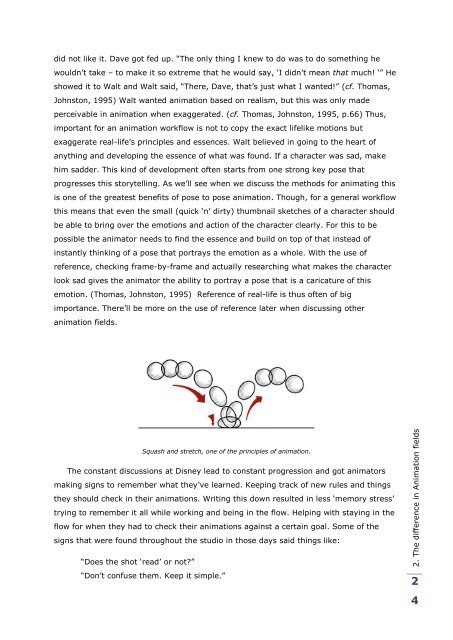Release. Pressure. Animate.
Release. Pressure. Animate.
Release. Pressure. Animate.
Create successful ePaper yourself
Turn your PDF publications into a flip-book with our unique Google optimized e-Paper software.
did not like it. Dave got fed up. “The only thing I knew to do was to do something he<br />
wouldn‟t take – to make it so extreme that he would say, „I didn‟t mean that much! „” He<br />
showed it to Walt and Walt said, “There, Dave, that‟s just what I wanted!” (cf. Thomas,<br />
Johnston, 1995) Walt wanted animation based on realism, but this was only made<br />
perceivable in animation when exaggerated. (cf. Thomas, Johnston, 1995, p.66) Thus,<br />
important for an animation workflow is not to copy the exact lifelike motions but<br />
exaggerate real-life‟s principles and essences. Walt believed in going to the heart of<br />
anything and developing the essence of what was found. If a character was sad, make<br />
him sadder. This kind of development often starts from one strong key pose that<br />
progresses this storytelling. As we‟ll see when we discuss the methods for animating this<br />
is one of the greatest benefits of pose to pose animation. Though, for a general workflow<br />
this means that even the small (quick „n‟ dirty) thumbnail sketches of a character should<br />
be able to bring over the emotions and action of the character clearly. For this to be<br />
possible the animator needs to find the essence and build on top of that instead of<br />
instantly thinking of a pose that portrays the emotion as a whole. With the use of<br />
reference, checking frame-by-frame and actually researching what makes the character<br />
look sad gives the animator the ability to portray a pose that is a caricature of this<br />
emotion. (Thomas, Johnston, 1995) Reference of real-life is thus often of big<br />
importance. There‟ll be more on the use of reference later when discussing other<br />
animation fields.<br />
Squash and stretch, one of the principles of animation.<br />
The constant discussions at Disney lead to constant progression and got animators<br />
making signs to remember what they‟ve learned. Keeping track of new rules and things<br />
they should check in their animations. Writing this down resulted in less „memory stress‟<br />
trying to remember it all while working and being in the flow. Helping with staying in the<br />
flow for when they had to check their animations against a certain goal. Some of the<br />
signs that were found throughout the studio in those days said things like:<br />
“Does the shot „read‟ or not?”<br />
“Don‟t confuse them. Keep it simple.”<br />
2. The difference in Animation fields<br />
2<br />
4


